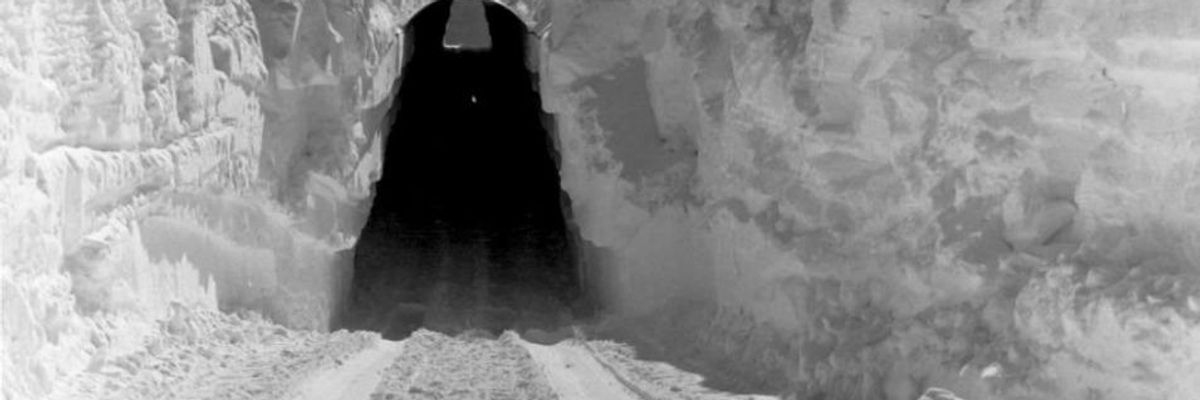The rapidly warming climate will melt Greenland's ice cap to such an extent that thousands of tons of hazardous waste left in the 1960s by a secret U.S. military base will be unearthed by the end of the century, new research finds.
The biological, chemical, and radioactive waste will then seep into the ground and the sea, endangering humans and animals alike.
"This stuff was going to come out anyway, but what climate change did was press the gas pedal to the floor and say, 'it's going to come out a lot faster than you thought.'"
--James White, University of ColoradoThe study published Thursday in the journal Geophysical Research Letters discovered that if today's rate of global warming continues unabated, within the next 75 years more ice will be melting than will be replaced by new snowfall.
"Once the site transitions from net snowfall to net melt, it's only a matter of time before the wastes melt out; it becomes irreversible," the study's lead author, William Colgan, said in a statement from the American Geophysical Union.
The waste was abandoned by Camp Century, a 200-person camp that resembled a city built under the ice. Built a mere 800 miles from the North Pole in subzero temperatures, its construction was a remarkable feat of engineering. The base was ostensibly created for scientific research, but its top-secret reason for existing was to test the feasibility of a network of nuclear launch sites within the Greenland ice sheet, a task known as Project Iceworm.
The base was in operation from 1959 to 1966, and Project Iceworm was canceled--when it became clear that unpredictable and extreme shifts in the ice sheet made it impossible--in 1963.
After Camp Century closed, "the military removed a portable nuclear reactor that had helped power the 200-person base, but left the rest of the waste there, from gasoline to PCBs and nuclear coolant water," Mashable noted.
Mashable reported that the study authors estimated that Camp Century "hosts approximately 9,200 tons of physical waste associated with abandoned infrastructure--equivalent to the mass of 33 Airbus A380s super jumbo jets, along with 20,000 liters of chemical waste associated with base fuel. This is about equivalent to the volume of a full-size tanker truck."
The outlet continued:
In addition, [the researchers] calculated that there is likely about 24 million liters of biological waste (mainly sewage), along with radioactive coolant water from the reactor.
The total area of the facility sprawls across about 136 acres, the study found, or about 100 football fields.
The study indicates that the most significant threat to the Arctic environment from the buried waste are polychlorinated biphenyls, or PCBs, which do not break down naturally in the environment and can build up in plants and animals, potentially causing cancer in humans.
The U.S. military assumed that the region's constant snowfall would entomb the waste in ice for many thousands of years.
"Two generations ago, people were interring waste in different areas of the world, and now climate change is modifying those sites," Colgan noted.
Indeed, as James White, a University of Colorado climate scientist who wasn't involved in the study, wrote in the American Geophysical Union statement: "This stuff was going to come out anyway, but what climate change did was press the gas pedal to the floor and say, 'it's going to come out a lot faster than you thought.'"
"The ice sheet that sits on Greenland is melting at an alarming rate, as much as 8,000 tons per second, said Colgan. This equates to 280 billion tons of ice melting and calving off into the ocean each year," USA Today wrote.
And the resulting seepage of radioactive, biological, and chemical waste will not only be an environmental disaster, the researchers noted. The issue also creates a political quandary: Camp Century was allowed to exist thanks to a U.S.-Denmark treaty--but its nuclear missile experiment was kept secret from the Danish government. Moreover, today Greenland is an independent country.
In addition, while international law "is clear about responsibility for preventing future hazardous waste," it is "ambiguous about who is liable for waste already discarded," Jessica Green, a political scientist specializing in international environmental law at New York University, told the American Geophysical Union.
Thus, the looming threat of unearthed nuclear and other hazardous waste "represents an entirely new pathway of political dispute resulting from climate change," the study authors observed.

